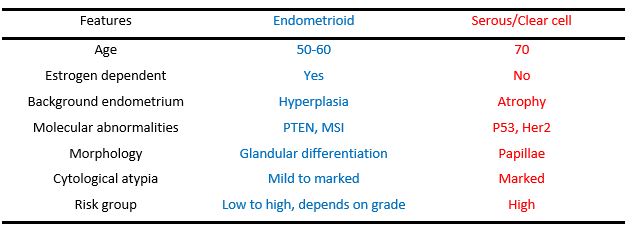Endometrioid type adenocarcinoma
Endometrioid type adenocarcinoma
Updated: 12/21/2020
© Jun Wang, MD, PhD
General features
- Type 1 (estrogen dependent) endometrial carcinoma
- In background of endometrial hyperplasia
- Associated with estrogen replacement therapy
- More common in white
Pathogenesis
- Prolonged estrogenic stimulation with reduced progestational activity
Clinical presentations
- Asymptomatic or uterine bleeding
Pathological findings
- Crowd irregular glands, possible fusion of glands
- Atypical cells
- Squamous metaplasia: benign squamoid changes, NOT counted as solid area for FIGO
- Weak p16 reactivity (strong p16 reactivity in serous carcinoma and endocervical adenocarcinoma)
FIGO grade
- I: well differentiated, <5% nonsquamous solid component
- II: moderately differentiated, 6-50% nonsquamous solid component
- III: poorly differentiated, > 50% nonsquamous solid component
- Upgrade with marked cytological atypia
Molecular abnormality
- Loss of function of PTEN
- MSI: microsatellite instability, Lynch syndrome
- Loss of function mutations in ARID1A
- Late stage: p53
Comparison with type 2 endometrial adenocarcinoma
Treatment
- Surgery
- Chemotherapy
Back to female genital tract
Back to contents

Comments
Post a Comment